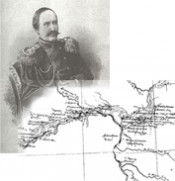
The Convention of Peking of 1860 is concluded
2 (14) November 1860, in Beijing, China and Russia concluded the Convention of Peking (in addition to the Tianjin one) that confirmed the Treaties of Aigun and Tianjin, and finally defined the eastern boundary between the possessions of Russia and China.
The introductory part of the convention, that consisted of 15 clauses, said: "By careful examination and discussion of the agreements between Russia and China, the Emperor and Autocrat of all the Russians, and the Bogdo Khan Daytsinsky, for the greater bond of mutual friendship between the two empires, for the development of trade relations and to prevent misunderstandings, decided to compose several additional clauses ...". On behalf of Russia the agreement was signed by the Russian envoy in China, Major-General N. P. Ignatiev; on behalf of China – by the Chinese Grand Prince, Kung-chin-van.
According to the convention, the eastern border between Russia and China was established from the confluence of the Shilka and Argun Rivers downstream the Amur River to the point where it flows into the Ussuri River. Lands lying on the left bank (to the north) of the Amur, were declared Russian ones; and on the right bank (to the south) – Chinese ones. Further, the boundary was set along the rivers of Ussuri and Sungacha, the Lake Hanka, the river Belenhe (Tour) and then along the ridge to the mouth of the river Hubitu (Hubtu, Ushagou) and from this place "through the mountains that lie between the river Hunchun and along the sea up to the river Tumen." And the lands lying to the east of this line, were declared the territory of Russia, and to the west – that of China. The agreement was accompanied with a map of the eastern section of the Russian-Chinese border. Thus, Russia finally secured the Ussuri region for itself.
The western border between the two countries was also agreed upon. It had to follow clear natural landmarks ("following the direction of the mountains, the flow of large rivers ") and "the lines of the existing Chinese pickets", from the pass Shabin Dabagov in Sayan ridge to Kokand possessions. It was provided that the demarcation of eastern and western parts of the Russian-Chinese border would be entrusted to trustees (commissioners).
The Convention regulated in detail the Russian-Chinese trade relations. Throughout the entire boundary line was permitted a free and duty-free barter between citizens of both countries. It was stated that "Russian merchants in China, and Chinese merchants in Russia were under the special protection of both governments." The Russian Government was allowed to open its consulates in Urga and Kashgar. The Chinese government, likewise, could nominate its consuls in the capital and other cities of the Russian Empire.
The clauses of the convention also regulated the appointment of consuls, established rules of diplomatic correspondence and provided the parties an opportunity to improve in future the rules of the land trade.
16 (28) June 1861, the protocol on the demarcation in the Ussuri region was annexed to the Convention of Peking as its integral part.
Lit.: Дополнительный договор между Россией и Китаем. Пекин, 2/14 ноября 1860 г. // Сборник договоров России с другими государствами. 1856-1917. М., 1952; То же [Электронный ресурс]. URL: http://www.hist.msu.ru/ER/Etext/FOREIGN/peking.htm; Международные отношения на Дальнем Востоке. Кн. 1. М., 1973. С. 102-104; Новая история Китая. М., 1972. С. 176-177.
Based on the Presidential Library’s materials:
Russia — China: on the history of relations : [digital collection;
Гром русских побед в Китае: (Разгром «Большого Кулака»). М., 1900;
Куропаткин А. Н. Русско-китайский вопрос. СПб., 1913;
Пещуров Д. А. Сборник договоров России с Китаем. 1689-1881 гг. СПб., 1889;
Nikolayevsky Post on Amur founded // On this day. 13 August 1850.

